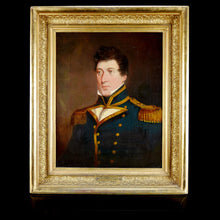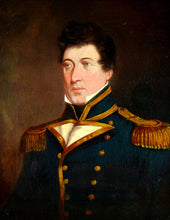Portrait of Captain Herbert Brace Powell RN - English School, 1820
- Regular price
- £2,600
- Sale price
- £2,600
- Regular price
-
- Unit price
- /per
Adding product to your cart
Overall: 56.5cm (22.2in) 47x cm (18.5in)
Oil on canvas. Head and shoulders portrait wearing 1812-25 pattern full dress of a captain with three years’ seniority denoted by the silver crown and anchor to the epaulettes. Canvas: 41cm x 33cm. Framed and glazed.
Rear-Admiral Herbert Brace Powell RN (1785-1857) was born in Leominster, Herefordshire and entered the navy as a twelve year-old midshipman in 1797, on board HMS Kangaroo, an 18-gun sloop-of-war of the Diligence class, captained by his uncle ‘Master and Commander’ Edward Brace RN. Kangaroo was small with a flush gun deck exposed to elements, and, having been cheaply built from fir rather than oak, was considered almost expendable.
Read more
The following summer Kangaroo ‘rendered essential service to the country by beating out of Cork harbour during a heavy gale of wind, and conveying information to the different cruisers on the Irish coast’, alerting them to the approach of a formidable French squadron intent on aiding the Irish Rebellion of that year. The French under Admiral Jean Baptiste Bompard were consequently encountered and defeated by Sir John Borlase Warren at Lough Swilly, after which Kangaroo was ordered to join the force assigned to hunting down fleeing French ships. On 15 October Midshipman Powell received his baptism of fire when Kangaroo ‘came up with, and engaged the enemy, in a most gallant manner; but unfortunately her fore-top-mast was shot away by the enemy’s stern-chasers, and Captain Brace was rendered incapable of pursuit’. Within a couple of days, however, Kangaroo’s crew of of 120 had replaced her fore-top-mast, rejoined the pursuit of the frigate Loire of 36-guns and 664 crew, which she captured after a spirited action in which Kangaroo brought down the enemy’s mizen-mast with a broadside, allowing Captain Brace to take the prize in tow, and proceed with her to Plymouth.
In 1800, Powell was in Kangaroo when she captured a French privateer and re-captured an American ship and two British merchantmen, spreading the ship’s company thinly with 44 officers and men absent in prizes, 6 unable to attend their quarters, and 4 employed below guarding her numerous prisoners. After passing his examination for lieutenant, Powell was ordered to Jamaica with a convoy; but was shipwrecked in the frigate Apollo (38-guns) on the coast of Portugal, with the ship being ripped to pieces on rocks in the midst of a violent and prolonged storm. ‘On her striking the second time, most pitiful cries were heard every where between decks, many of the men giving themselves up to inevitable death …’
Powell’s next appointment was again under his uncle Captain (later Admiral Sir Edward) Brace in the former French 40-gun frigate on the Irish station, where he assisted at the capture of the Dutch 36-gun frigate Guelderland and two Spanish privateers; also at the recapture of various British merchantmen, and in defending the Louisa hired tender against the French privateer Marsouin for which latter service he received the thanks of the Admiralty. In October 1810, he followed Captain Brace, as his first lieutenant, into the St Albans (64), which, after refitting at Chatham, was stationed at Cadiz where the Spanish were besieged by 70,000 French under Marshals Victor and Soult until 1812 when the enemy abandoned their lines before the city and l’Isla de Leon. In 1811 Powell lost his brother, a midshipman in HMS Hero (74) when that ship was wrecked on the Haak Sand near the Texel.
Powell was was finally promoted to the rank of commander in June 1814, but with the Napoleonic Wars nearing their end, he next went to sea as a volunteer in July 1816 in the Rear-Admiral Milne’s flagship Impregnable (104), commanded by Captain Brace, as part of Admiral Lord Exmouth’s anti-slavery expedition to Algiers. During the Bombardment of Algiers, Brace miscalculated Impregnable’s position and anchored too close to the Moors’ gun batteries defending the port, preventing his men from depressing their guns sufficiently to inflict any damage on the fort while coming under heavy bombardment themselves. Impregnable suffered 210 casualties and Brace was blamed. In the midst of this bloody exchange, Powell went to Lord Exmouth, informing him of Impregnable’s predicament, and requesting him to send a a frigate to divert some of the enemy’s fire. On his return, he was ordered by Admiral Milne to prepare a bomb-vessel packed 143 barrels of gunpowder and send it under the semicircular battery to the northward of the light-house, where she blew, creating a diversion in favour of the dreadfully cut-up Impregnable. Algiers capitulated next day.
Powell was soon afterwards appointed to the command of HMS Heron in home waters until 1819. He was promoted post captain in 1822, and eventually Rear Admiral. He retired and built Heron Lodge at Whittington near Worcester, and is said to have planted a willow in the garden taken from cutting from the weeping willows at the head of Napoleon’s grave on St Helena.
Source: John Marshall’s ‘Royal Navy Biography’ (1823-35).








